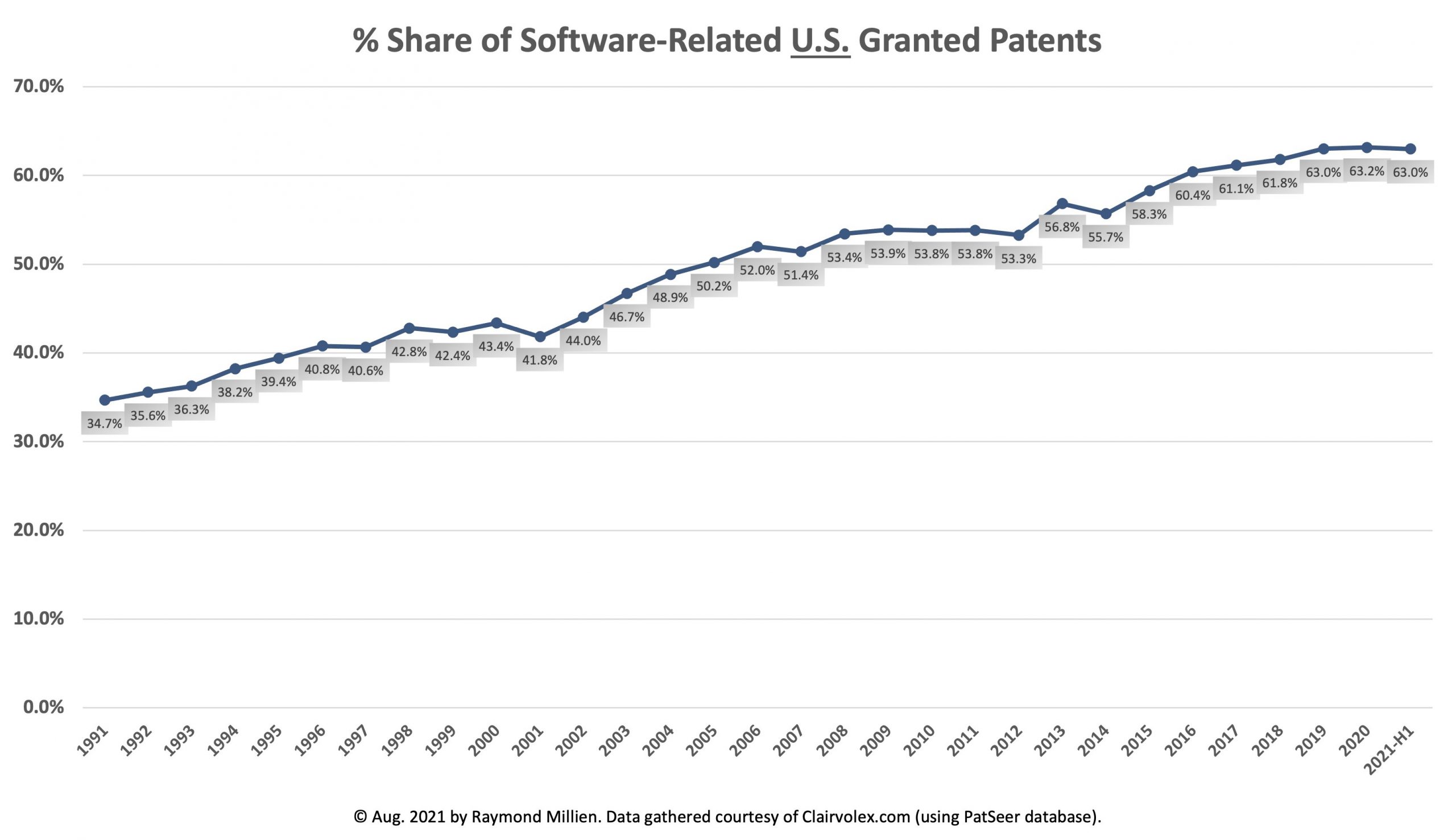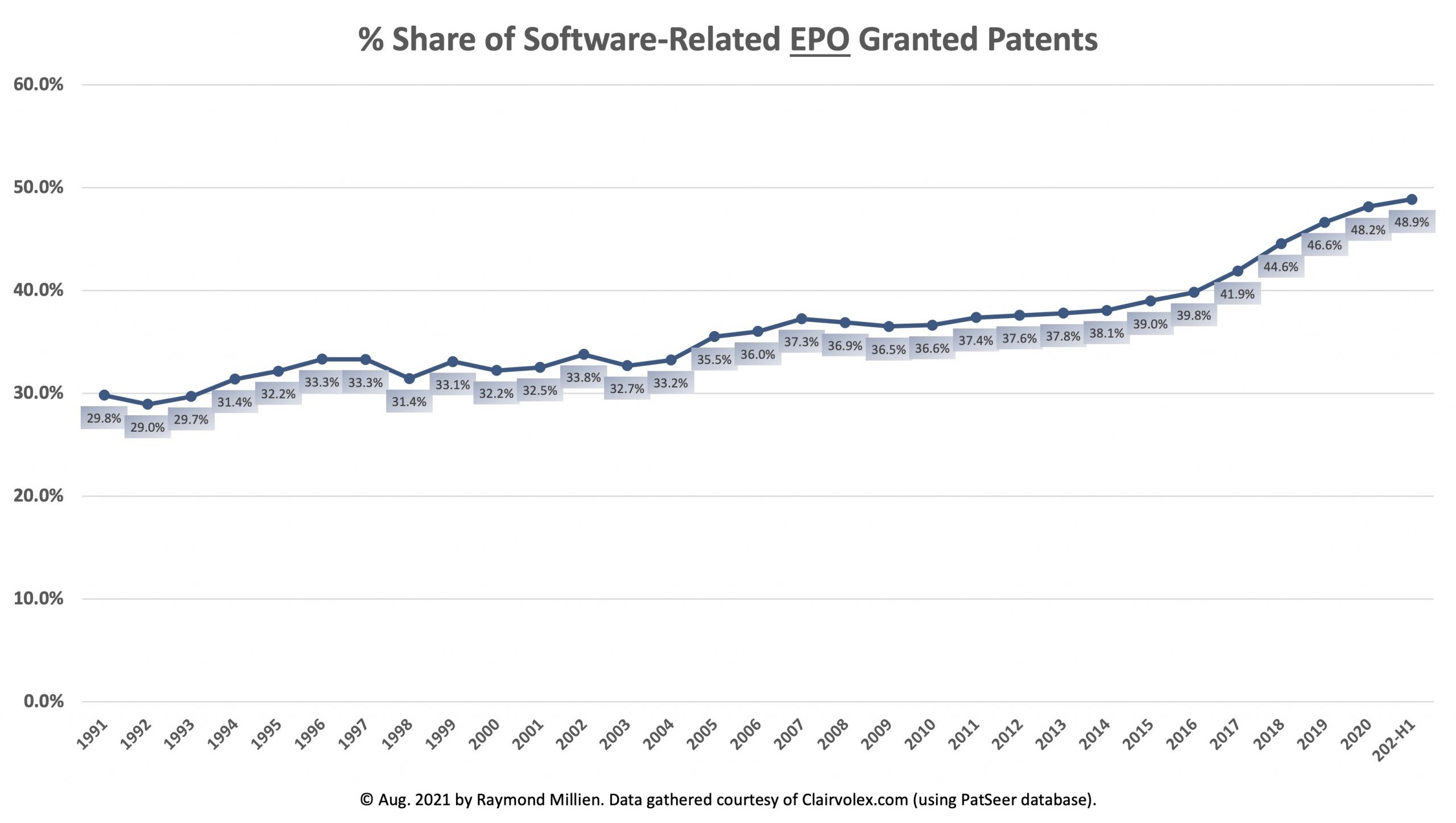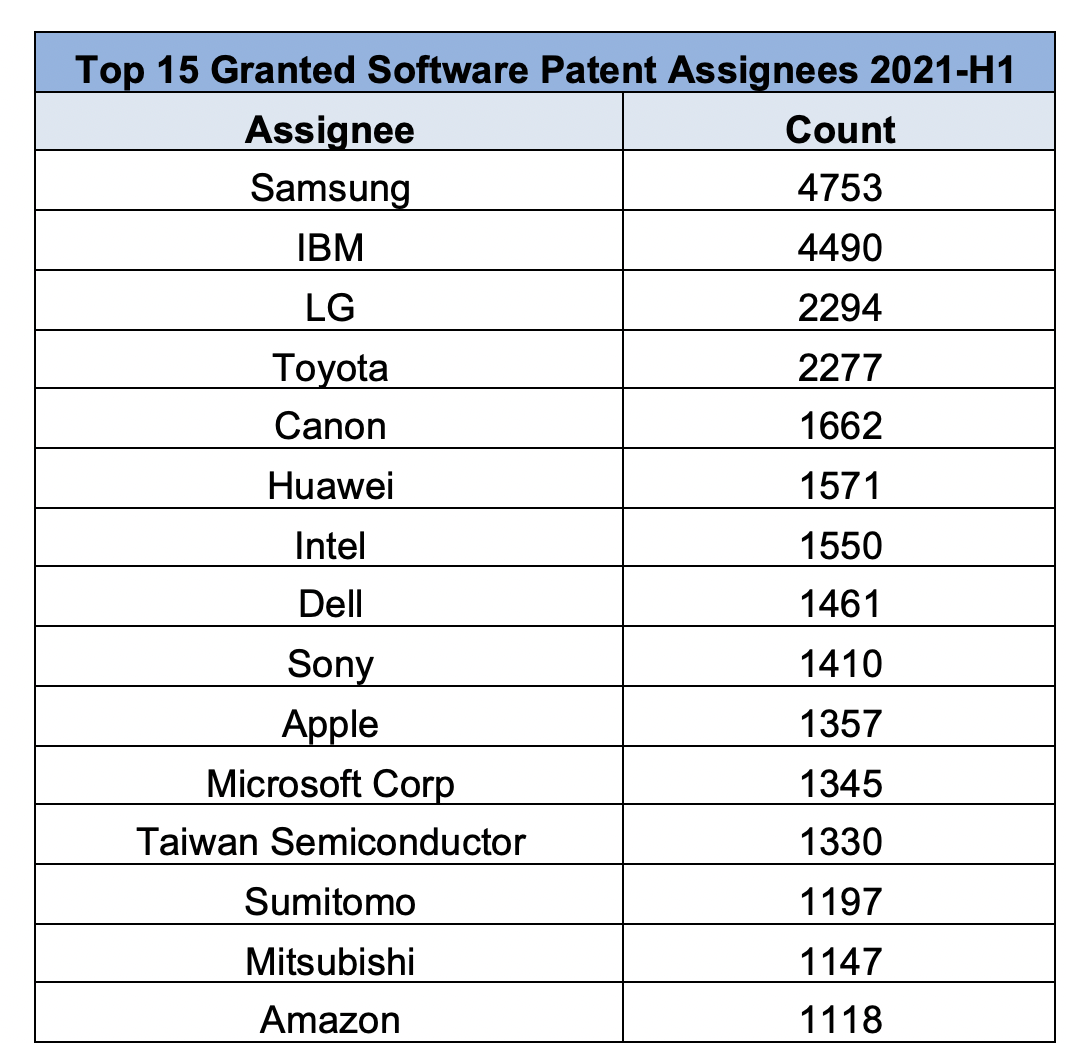“Today, the digital transformation where software is ‘eating the world’ is undeniable. Here are the latest facts and figures from the USA, Europe and China.”
 As an update to my posts from 2017, 2019, 2020, and March 2021, it has now been 86 months since the U.S. Supreme Court’s 2014 Alice Corp. v. CLS Bank decision. Yet the debate still rages over when a software (or computer-implemented) claim is patentable versus being simply an abstract idea “free to all men and reserved exclusively to none” (as eloquently phrased over 73 years ago by then-Supreme Court Justice Douglas in Funk Bros. Seed Co. v. Kalo Inoculant Co.).
As an update to my posts from 2017, 2019, 2020, and March 2021, it has now been 86 months since the U.S. Supreme Court’s 2014 Alice Corp. v. CLS Bank decision. Yet the debate still rages over when a software (or computer-implemented) claim is patentable versus being simply an abstract idea “free to all men and reserved exclusively to none” (as eloquently phrased over 73 years ago by then-Supreme Court Justice Douglas in Funk Bros. Seed Co. v. Kalo Inoculant Co.).
Further, it has been 10 years since famed venture capitalist Marc Andreessen wrote the influential and often-quoted op-ed piece in the Wall Street Journal titled “Why Software Is Eating the World.” Today, the digital transformation where software is “eating the world” is undeniable. Let’s look at some facts and figures from the USA, Europe and China.
It’s All in the Numbers
In 2020, the global M&A activity in the software and Internet services space reached USD 158 billion, representing over 2,790 deals [IMAA]. The United States is the largest technology market in the world, representing 33% of the total estimated IT spend for 2021 (or approximately USD 1.6 trillion), followed by Europe at 19% and China at 14% [CompTIA].
The European software market (including business productivity and security software) is expected to amount to approximately USD 127.4 billion in 2021 [Statista]. The EU software industry delivers EUR 910 billion (USD 1.07 trillion) in total value-added GDP (over 7% of the EU28 total GDP) [BSA]. As of 2018, the European software industry has been growing five times faster than the rest of the EU economy [Dataconomy].
In 2020, Chinese companies’ software-related business revenue was RMB 816.16 trillion (about USD 1.26 trillion), an increase of 13.3% compared to 2019 [Ministry of Industry and Information Technology of People’s Republic of China]. Among them, revenue from software products was RMB 227.58 trillion, revenue from IT services was RMB 498.68 trillion, revenue from information security was RMB 149.8 billion, and revenue from embedded system software was RMB 749.2 billion [Ministry of Industry and Information Technology of People’s Republic of China]. In the first half of 2021, the software business in China continues to boom, experiencing a 23.1% increase in revenue when compared to the first half of 2020 [Ministry of Industry and Information Technology of People’s Republic of China]. In fact, the employment prospect of computer and information science majors in China is among the nation’s top three with an approximately monthly income of RMB 6858 in 2019 [China Central Radio and Television] and RMB 7396 in 2020 [Sohu News].
So, given the above, we sought to determine what percentage of U.S. Patent and Trademark Office (USPTO), European Patent Office (EPO)-, and Chinese Patent Office (CNIPA)-issued patents are “software-related”?
To define what patents are “software-related,” we utilized the same methodology employed by the United States Government Accountability Office in a 2013 report to Congress. That report relied on certain United States Patent Classification (USPC) classes and subclasses of applications most likely to include software-related claims as selected by expert advisors to the USPTO. Now, with the assistance of IP services firm Clairvolex (and after converting from the USPC system to the Cooperative Patent Classification (CPC) system), data was pulled from the PatSeer Global Patent Database. The results?
In the first half of 2021:
- 63% of issued U.S utility patents were “software-related” (on pace with 63.2% for all of 2020)
- 48.9% of granted EPO patents were “software-related” (on pace with 48.2% for all of 2020)
- 40.1% of granted Chinese patents were “software-related” (on pace with 40.2% for all of 2020)



Digging deeper into these numbers, we found that the top 15 software-related U.S. granted utility patent assignees for the first half of 2021 were:

Still Waiting
Meanwhile, back at the U.S. patent bar, the USPTO, Federal Circuit, Supreme Court, and Congress have not cleared the Alice Section 101 confusion. As former – and still to be replaced – USPTO Director Andrei Iancu stated in his farewell speech at the U.S. Chamber of Commerce on January 19, 2021, “Will [we] finally resolve this issue that has plagued our [patent] system for the past decade?” We’re still waiting…
Image Source: Deposit Photos
Copyright: zsoltercsei
Image ID: 31555133

![[IPWatchdog Logo]](https://ipwatchdog.com/wp-content/themes/IPWatchdog%20-%202023/assets/images/temp/logo-small@2x.png)


![[Advertisement]](https://ipwatchdog.com/wp-content/uploads/2024/04/Patent-Litigation-Masters-2024-sidebar-early-bird-ends-Apr-21-last-chance-700x500-1.jpg)

![[Advertisement]](https://ipwatchdog.com/wp-content/uploads/2021/12/WEBINAR-336-x-280-px.png)
![[Advertisement]](https://ipwatchdog.com/wp-content/uploads/2021/12/2021-Patent-Practice-on-Demand-recorded-Feb-2021-336-x-280.jpg)
![[Advertisement]](https://ipwatchdog.com/wp-content/uploads/2021/12/Ad-4-The-Invent-Patent-System™.png)







Join the Discussion
9 comments so far.
Anon
August 30, 2021 01:43 pmGiven the current state of affairs vis a vis eligibility (and how that usually drives comment numbers up), I am rather surprised at the lack of comments here from those that typically despise the form of innovation that is so often reflected in the computing arts design choice of software.
Perhaps the cold hard facts of numbers are just too difficult to fold into a desired narrative.
Night Writer
August 27, 2021 10:04 amThe reality is that under Ultramercial (Laurie’s version) none of the software patent applications are valid. There are arguments that there have been carveouts like at the EPO for software that is essentially hardware for a computer (which, by the way, is not logically consistent with the contentions made in Ultramercial.)
Night Writer
August 27, 2021 08:17 amThe case we in the USA need to go after is Ultramercial (Laurie’s version). The entire problem we live with today in software can be seen by reading the Ultramercial (Rader pre-Alice) and Ultramercial (Laurie post-Alice.)
concerned
August 27, 2021 06:15 amInterestingly, SCOTUS 6-3 ruled last night against Biden’s eviction moratorium staing only Congress can impose a nationwide moratorium.
Yet SCOTUS can insert words (judical exceptions) on s101 without definition and without Congress that are applied nationwide.
PTAB stated my application met the law as passed by Congress, however, PTAB argued my application did not meet the courts’ (undefined) definition.
My only consolation is I do not rent, thus I cannot be evicted otherwise SCOTUS would be giving me dual action.
concerned
August 27, 2021 05:56 amCurious: This article would have been more informative if it revealed the issuance percentage rate of the big boys vs. Joe Nobody.
IBM is on track to receive another 9,000 patents this year, while “IBF” prosecution seems to be deny at all cost.
Anon
August 26, 2021 04:41 pmAre those EPO results “per se” and “as such”?
(asking for a friend)
😉
Eileen McDermott
August 26, 2021 04:15 pmMy fault MaxDrei – it’s fixed now.
Curious
August 26, 2021 03:08 pmAnd the Federal Circuit just invalidated (yet again) another software related patent under 35 USC 101 in Universal Secure Registry v. Visa. Software patents can only be held by large conglomerates — so they can be used to block smaller companies from trying to compete. On the other hand, the software patents held by smaller companies are regularly held invalid by the Federal Circuit — because these large conglomerates need all the help they can get.
US Patent Law — the sport of kings where the golden rule applies — he has has the gold makes the rules.
I would have been saddened by this decision had I not seen the same thing dozens of times already. I’m almost immune to the inanity that pervades the Federal Circuit.
MaxDrei
August 26, 2021 02:44 pmDo I see it right, that you show the EPO plot twice, the China plot once, and the USPTO plot not at all? Perhaps a correction is needed, especially since these data are quite interesting and since the shape of the trace is different, as between the EPO and in China. What might the shape of the USPTO trace be, I wonder.